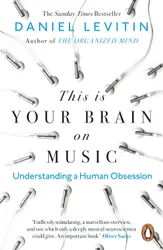The author of this book, Daniel Levitin, is in a unique position to understand and explain the neuroscience of music, having worked as a musician and music producer before becoming a cognitive neuroscientist. This book is an attempt to understand music from the point of view of our brains, and the processing that goes on within them when listening to (and making) music.
I was impressed by just how much is going on in the brain when listening to music. A series of vibrations through the air is turned into an understanding of what separate instruments are playing (and where they are in space), what pitches are being played, the meter and tempo of the song, and over time the structure of the song is discerned. Meanwhile, if there is a vocalist, words are being understood as well. Simply by listening to music, your brain is doing a lot of work!
One of the questions this book aims to answer is why music is so compelling to us and is pleasurable to listen to. It tries to do this in terms of the structures in our brain and the way in which they process the sound we hear. This includes rhythm, tempo, pitch and timbre, and our expectations for what we’re hearing. These different aspects of music are processed in different parts of our brain at the same time. One view is that this is enjoyable because it’s kind of a game for the brain to play. The brain might be searching for a ‘right’ answer for how to interpret this mass of sound hitting the ears, and when a coherent pattern emerges, it gets a satisfying pleasure out of it.
One question that occurred to me about this explanation, as plausible as it sounds, is why we don’t get quite the same pleasure out of visual images as we do from music. Certain types of imagery are very popular (photographs of attractive humans, for example), and obviously we do place pictures of loved ones, or attractive art, in our homes. I like visual art too, but for me, images don’t provide the same type of feeling as music does. There may be people who do get a lot of pleasure from looking at art, but for most people I think music has something that visual art doesn’t. Presumably the amount of processing required to interpret an image is similar to that required to listen to music, so why doesn’t it appear to have the same effect on us? The tempo aspect is missing in a static image, so that could be part of it. We do like watching moving images, of course. But our most popular moving image content consists largely of stories about other humans, and I can see why this is compelling from our place in the world as social animals i.e. it taps into our love for story and understanding our own place within a social group or hierarchy. It’s also worth noting that most of the most popular movies have music playing constantly while the action is taking place. So I feel that the particular type of enjoyment we get from music is still something of a mystery.
The book also explores the question of whether music is a beneficial adaptation, conferring survival or reproductive benefits to those humans who practice it (or just listen to it), or whether the existence and enjoyability of music is a side-effect of other adaptations. Another question is whether the ability to appreciate music is encoded genetically or is learned from our environment as we develop; the old nature versus nurture debate. The author makes the case that the understanding and appreciation that those raised in the context of the western musical tradition (do-re-me-fa-sol-la-ti-do) is dependent on that context, and the reason that other musical traditions, such as Indian music for those raised listening to western music, sound strange to us is that we weren’t raised with that music in our ears from an early age.
There are a lot of references to different musical pieces throughout this book. I found a Spotify playlist containing all the music mentioned in the book, and as I read I listened to some of the music that I wasn’t already familiar with. It made reading the book a fun interactive experience. The aspect of the book that I enjoyed the most was the author’s descriptions of musical features in the tunes and how these might provide enjoyment when processed by the brain. It exposed me to some songs I didn’t know, and made me listen to songs I did know in a new way. The author’s understanding of music and passion for the subject shows through in the writing.
I found the neuroscience stuff to be a bit light, and I don’t feel like I learned all that much about the brain from this book. But I really enjoyed thinking about what must be going on in the brain to make sense of music, and I think those who like music would enjoy reading this book.
